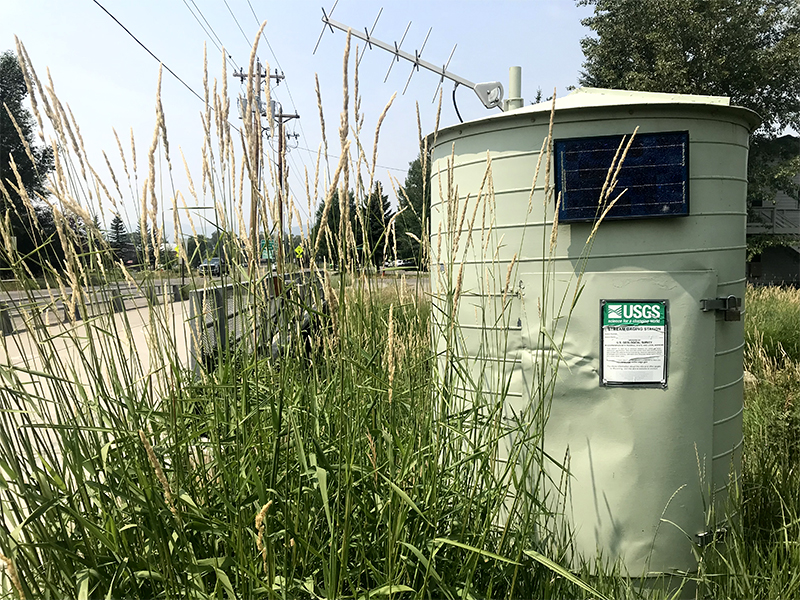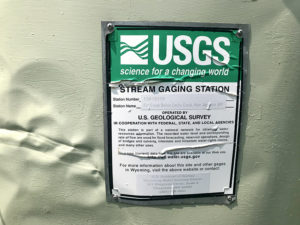As you’re driving west on Jackson’s High School Road, a little olive green structure is perched on the right, just before the bridge over Flat Creek. It looks like a mini silo with an antenna on top, and if you get up close, there’s a sign that reads, “USGS Stream Gaging Station.”
That’s where KHOL met Carlin Girard, water resources specialist and associate director of the Teton Conservation District, a local government entity, in order for him to explain how a gaging station works and how it helps tell us that Teton County is officially in drought.
“Stream gages have changed quite a bit over the years. So, what you can physically see here is an antenna and a little building that we used to use all the time, which is called the stilling well,” Girard said. “And really what it [the gage] is, is a pipe that’s holding a cable down to a pressure transducer. And what the pressure transducer does is measures the amount of weight and water sitting on top of the device and then [it] can calculate an elevation.”

The U.S. Geological Survey’s stream gaging station at Flat Creek below Cache Creek is located at the intersection of Flat Creek and High School Road. (Kyle S. Mackie/KHOL)
It’s a little complicated, but basically from that measurement of the depth of water, the U.S. Geological Survey then uses a model to measure the stream’s discharge at that point in time. (“Simple math!”)
The gaging station can also measure temperature and turbidity, a proxy for suspended sediment concentrations in the water, according to Girard. Part of his job is summarizing all that data for the local community and water managers.
“I oftentimes do it during flood periods in order to help people understand how the current flood situation compares to previous years or record years. This year, I’ve actually—it’s the first time I’ve been in this situation—have been doing the inverse and really making these comparisons with regard to low water years and drought conditions.”
MACKIE: Can you give us an overview of where we are right now in Teton County?
GIRARD: So, Teton County, Wyoming, is in Severe Drought*, according to the U.S. Drought Monitor. And really what that means is… we’re experiencing low stream flows. Groundwater availability is a little bit more limited and some people are running into issues, and generally, I think from the conservation district’s perspective, we’re in a position where we want to start to be proactive because as water availability decreases, you start to run into more issues.
MACKIE: So how rare is it for all* of Teton County to be in this Severe Drought status?
GIRARD: We’ve experienced conditions fairly similar to this in 2016, from a water perspective. But I would say the last time we experienced something of this nature was probably about 30 years ago. And, you know, the things that I’m thinking of are the way that Jackson Lake is being managed and Palisades [Reservoir] are being managed or looking at stream flows and truly how low stream flows are.
MACKIE: Okay, so what is the role of the community? You know, residents here, visitors to Jackson Hole—how can we help?
GIRARD: I think it’s about being more conscientious with water use. It comes down to recognizing that we all have this tiny little incremental effect, but that it all adds up together to be quite substantial. And there’s a lot of little things we do every day that use water, obviously, in our home, things like bathing and flushing toilets, washing cars, washing our dishes, washing our clothes. All of those things can be done in a way that’s more water-conscious. And around here, because we have a lot of water, typically our norm is to not really think about those things.
So, in our home, we can use less water by showering a little bit less frequently or for shorter periods of time. [And by] only running your dishwasher when it is completely full or you’re really thinking about that in terms of your clothes as well. I think some of the big savings can come from our landscape practices and how we manage green areas around our homes. I think even in these conditions, people overwater to a really, really large extent… the rule of thumb is typically about 15 minutes per area. Every other day is enough to keep grass green around here, and anything more than that is really depleting your soil of nutrients and is just wasted water.
Girard said there’s also been more water use this summer compared to other years because of hot, dry weather conditions and huge numbers of tourists. The Town of Jackson, for example, reported using 15% more water this June compared to the same month in 2020. That’s the equivalent of about 34 Olympic-sized swimming pools.
“I think as a water specialist in this community, I would say there’s almost a large amount of entitlement and kind of deflection of responsibility around these topics. And I’m very interested in trying to help change that perspective, swing it more towards the realistic reality that water issues in Teton County are a collective problem that take collective action,” Girard said.
“This is a really good time to rethink some of the some of the things we do here, like have really large green lawns that are polluting to our groundwater and our surface water [and] exhaust water resources during drought periods, and instead think about that as a potential opportunity for maybe native habitat restoration that doesn’t use as much water or things that we can do in our personal lives to maybe kind of exemplify what we would like to see instead of placing that responsibility onto others.”
Girard also said that regardless of whether the current drought can be attributed wholly to climate change or a combination of natural climatic variation, it should serve as a lesson of how climate instability results in very real consequences for humans, even in places like Teton County that are generally perceived to be water-rich.
*While most of Teton County, Wyoming, is currently experiencing Severe Drought, the northeastern corner of the county is in Extreme Drought, according to the latest U.S. Drought Monitor data.








